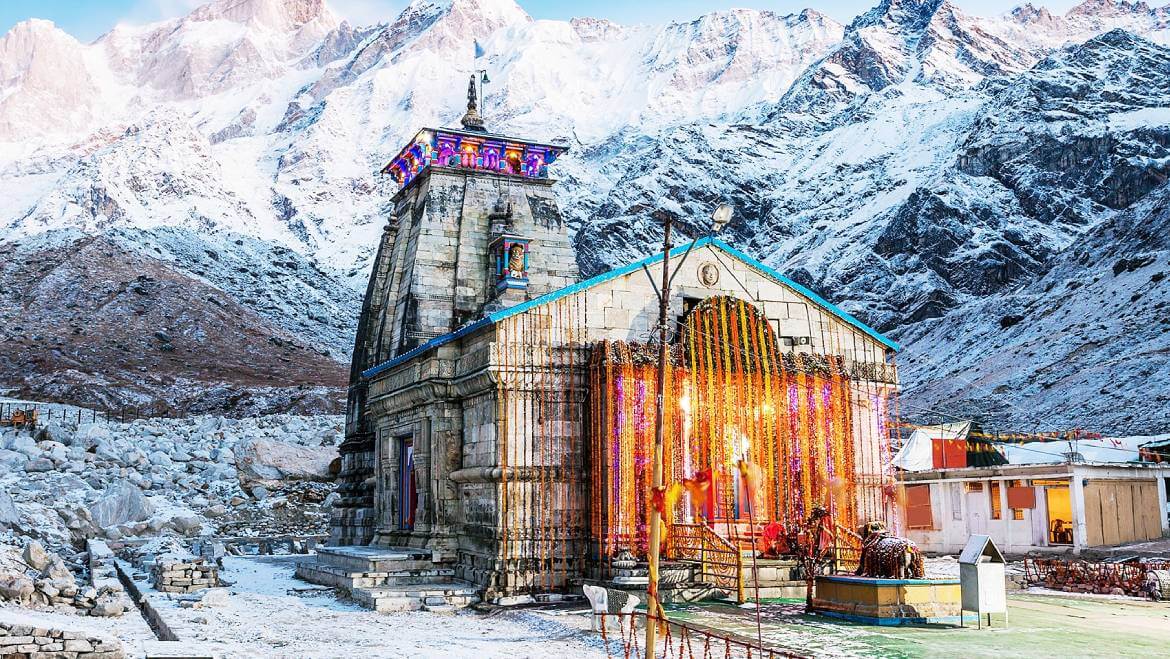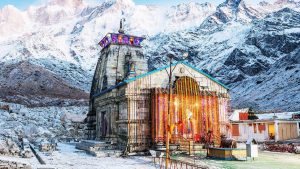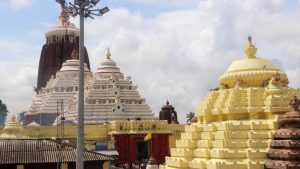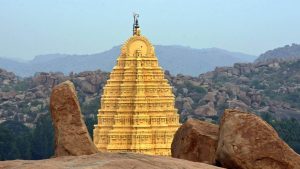The northern part of India, which encompasses the land from northern plains along the holy Ganga River to the mighty snow-capped mountains of the Himalayas, has some of the most pious and highly auspicious temples. These sites of spiritual significance attract millions of devotees and pilgrims every year, not only from India but also from around the globe. North India has a high reputation for pilgrimage tourism and boasts prominent spiritual destinations such as Kedarnath and Badrinath temples from the Char Dham pilgrimage circuits, temples dedicated to Lord Ram and Krishna, some prominent Jain temples, and the holiest Sikh pilgrimage site – the Golden Temple.
However, if you try to jot down the list, it seems to go on forever. Thus, we have enlisted a handful of the 12 best temples to visit in North India that stand among the most awe-inspiring and revered temples to withstand the test of time. These temples will not only help you rejoice in the spiritual feeling within yourself but also explore the unique cultural heritage of different parts of India.
- Badrinath Temple – Chamoli, Uttarakhand
- Prem Mandir – Vrindavan, Uttar Pradesh
- Kedarnath Temple – Rudraprayag, Uttarakhand
- Kashi Vishwanath Temple – Varanasi, Uttar Pradesh
- Amarnath Cave Temple – Jammu and Kashmir
- Akshardham Temple – Delhi
- Shri Digambar Jain Lal Mandir – Delhi
- Ranakpur Temple – Pali, Rajasthan
- Mansa Devi Temple – Haridwar, Uttarakhand
- Iskcon Temple – Vrindavan, Uttar Pradesh
- Vaishno Devi – Katra, Jammu and Kashmir
- Golden Temple – Amritsar, Punjab
Popular North India Pilgrimage & Temple Tour Packages
Badrinath Temple – Chamoli, Uttarakhand
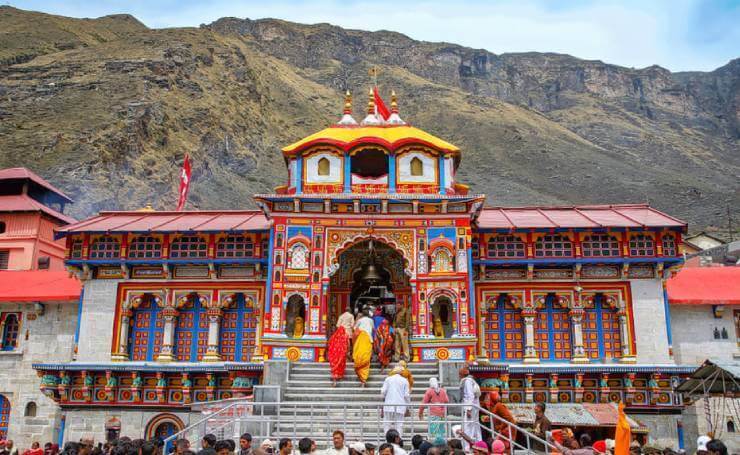
A pilgrimage to the Badrinath temple is a significant and cherished aspiration for many Hindus. Badrinath is one of the four sacred religious sites, along with Dwarka, Jagannath, and Rameshwaram. These holy abodes hold great religious importance in Hinduism. Completing the Char Dham Yatra, which includes the arduous journey to all four Dhams, is believed by devout Hindus to ensure liberation from the cycle of rebirth and grant eternal salvation.
Badrinath is also a crucial part of the Chota Char Dham Pilgrimage circuit of Uttarakhand, alongside Gangotri, Yamunotri, and Kedarnath. Geographically, Badrinath and Kedarnath are relatively close but still have over 180 kilometres of road between them. Pilgrims often undertake a coupled visit to both Badrinath and Kedarnath in North India during their pilgrimage tour in the Himalayas.
Architecture of the Temple
Badrinath temple is built in North Indian and Buddhist architecture. The main sanctum and hall are built with large slabs of stone and wood depicting the North Indian design, while the outer entrance built in a conical shape with gold plated roof depicts the Buddhist architecture. The arched gateway is adorned with intricate carvings, colourful motifs and flora patterns. Pillars in the temple are decorated with elaborate carvings of scenes from Hindu mythology. Badrinath temple is architectured to face east direction, as the direction of the rising sun is considered auspicious in Hindu religion.
Special Things to Know About the Badrinath Temple
- Not just the temple, but the whole Badrinath town is considered sacred to Hindus.
- Throughout history, numerous gods and sages, including Lord Vishnu, Lord Shiva, Prahalad, and Adi Shankaracharya, have visited and meditated in Badrinath.
- According to Hindu mythologies, the origin of the temple dates back to Lord Vishnu, who meditated here and was protected from extreme cold by the Badri (Ber) tree.
- Adi Shankaracharya played a crucial role in re-establishing Badrinath as one of the four most sacred pilgrimage sites in the Hindu religion.
- Despite being relatively easier to reach than Kedarnath, Badrinath remains among some of the hostile pilgrimage destinations, even with the introduction of roads and helicopter rides.
Timing: 6 AM to 12 PM and 4 PM to 9 PM (opens from April/May till October)
How to Reach Shri Badrinath Temple?
Rishikesh is the nearest Railway station (287 km) to Badrinath while Dehradun is the nearest airport (300 km). Both from Rishikesh and Dehradun, take a taxi or Bus to reach Badrinath Dham, which will be an 8-12-hour trip.
Prem Mandir, Vrindavan, Uttar Pradesh
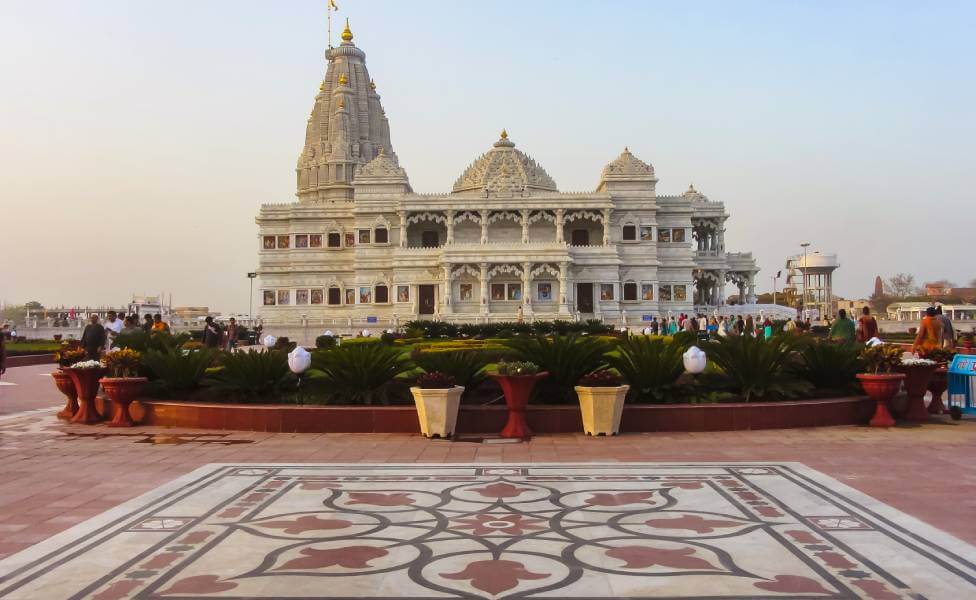
Prem Mandir is one of the most popular tourist destinations in North India, even though it is a more recent addition to the temple of Vrindavan. The temple, which was constructed on the teachings of Lord Krishna, is a reflection of his miracles and life lessons, with a focus on love. Translating to “Temple of Love,” “Prem Mandir” honours its heavenly allure fashioned from white marble. The facility, which occupies 54 acres, gives guests a sense of reverence. The temple, which honours the love of Goddess Sita and Ram as well as Radha and Krishna, is a sophisticated representation of artistic talent and devotion. With amenities for a full-day experience, such as morning prayers and night time sound and light performances, visitors can stay for as long as they choose.
Architecture of the Temple
Prem Mandir combines contemporary architecture with traditional Indian designs. This architectural wonder honouring Radha Krishna features a distinctive fusion of Gujarati, Somnath, and Rajasthani elements. The imposing main temple is a well-known landmark with a 169.78-meter dome decorated with fine sculptures and gold plating. Offering a glimpse into the heavenly love story of Radha and Krishna, the outside walls, which are divided into 48 panels, are adorned with numerous legends and anecdotes about them. The surrounding perimeter of the temple has serene gardens and tranquil atmosphere making it one of the beautiful temples to visit in North India. The complex’s spiritual ambience is further enhanced by life-size representations of Krishna’s leelas.
Special Things to Know
- Prem Mandir was completed with its construction in a span of two and a half years, from 2009 to 2012.
- The temple building is entirely made of white marble, which was brought from Rajasthan.
- The temple architecture is mostly inspired by the temples of Mathura and Vrindavan.
- A sound and light show is held every evening between 6-7 PM in the temple which plays many beautiful scenes from Lord Krishna’s life.
- Entry to the temple and Prasad is free in the Prem Mandir for everyone.
Timing: 5:30 am to 9:30 pm every day.
Location: Shri Kripalu Maharaj Ji Marg, Raman Reiti, Vrindavan, Uttar Pradesh 281121
How to Reach Prem Mandir in Vrindavan?
Vrindavan is 150 kilometres from Delhi. Take a taxi, bus, or train from Delhi to Vrindavan. The journey will take 3-4 hours.
Kedarnath Temple – Rudraprayag, Uttarakhand
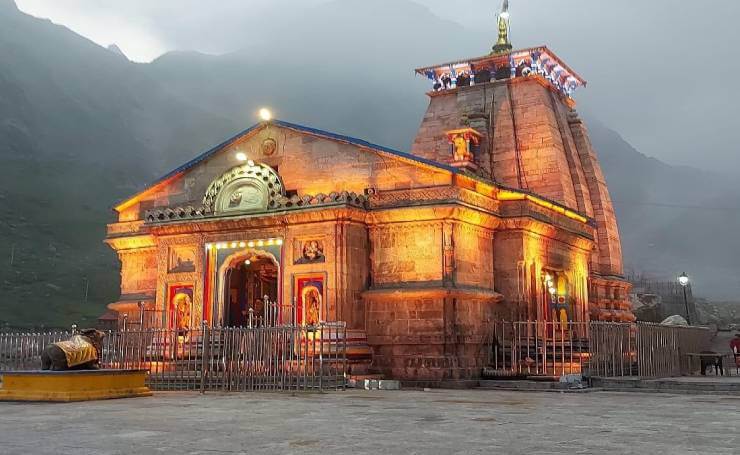
Commencing the Kedarnath Yatra reveals a profound spiritual journey that is enhanced by the rich mythology and rich history surrounding the holy Kedarnath Temple. Kedarnath, which translates to “Lord of the Field,” is one of the twelve Jyotirlingas, a part of the holy Chota Char Dhams and Panch Kedars, and has a certain charm that entices pilgrims to brave the difficult terrain of the Garhwal Himalayas. The thing that makes it a must visit temple in North India is its elevation of 3,583 metres and its exclusive six-month opening period. This holy place in the Garhwal Himalayas is constructed with large grey stone slabs and is adorned with exquisite architecture. It is also believed that Pandava brothers from the Mahabharata have also visited this temple.
Set against a backdrop of snow-capped peaks, including the majestic Kedarnath peak, the town offers both a spiritual haven and a picturesque retreat. The ancient history of the Kedarnath Temple, dating back to the 8th century and linked to Adi Shankaracharya, adds profound significance to the pilgrimage, underscored by the temple’s resilience during the 2013 floods, attributed to its historical construction and the protective Sri Divya Bheem Shila.
Architecture of the Temple
It is believed that Adi Shankaracharya built the temple next to the Mandakini River in the eighth century. The building is designed in the traditional temple architecture of North India, which is distinguished by its strong stone structure. A hallowed lingam, representing the Hindu god Lord Shiva, is kept in the main sanctuary, known as Garbhagriha.
The temple’s exterior is decorated with well-carved statues of deities and other motifs, giving it a modest yet attractive look. The enormous stone slabs that were used in the temple’s construction helped it withstand the severe alpine weather. With the snow-covered peaks in the background, the shikhara (spire) rising to the sky’s top forms an amazing silhouette. To get to the temple, pilgrims must climb a set of steps, which enriches their spiritual experience.
Special Things to Know
- The only way to reach Kedarnath is trekking while the altitude of above 3,500 metres and the tough location add to the challenge as you go through rugged terrain and face varying weather conditions to reach the temple.
- The temple’s high-altitude setting makes it one of the most elevated among the Chota Char Dham pilgrimage sites of Uttarakhand.
- The final visit on Adi Shankaracharya’s journey to restore Hinduism was Kedarnath. It is thought that in the eighth century, Adi Shankaracharya built the temple. Further, Adi Sankara is believed to have died at the age of 32 in Kedarnath.
- Despite being subjected to delirious natural calamities and harsh weather conditions over the centuries, the temple has been reconstructed several times and stands as a symbol of resilience.
- The area is also home to diverse flora and fauna, contributing to the overall charm of the pilgrimage.
- During the winter months, the region becomes snowbound, and the temple is inaccessible and closed. During the winter, the temple’s deity is moved to Ukhimath in Omkareshwar Temple. The deity is worshipped in Ukhimath for the next six months
Timing: 6 AM to 3 PM and 5 PM to 7 PM
Location: Kedarnath, Rudraprayag, Uttarakhand 246445
How to Reach Shri Kedarnath Dham Mandir?
The nearest railway station to Kedarnath is Haridwar Railway Station (241 km) and nearest airport is the Jolly Grant Airport in Dehradun (239 km). From there, you can take a taxi or a bus to reach Gaurikund, which is the closest point to the temple accessible by motor-vehicles. From Gaurikund onwards, it is 16 kilometres of trek to reach the Kedarnath temple.
Kashi Vishwanath Temple – Varanasi, Uttar Pradesh
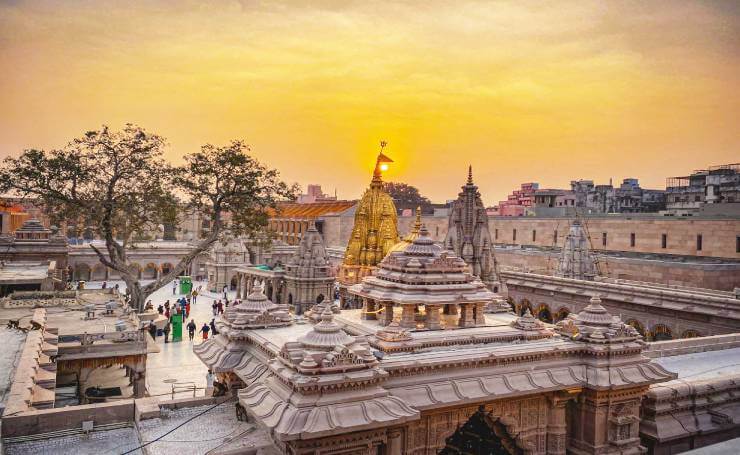
The Kashi Vishwanath Temple, located in Varanasi on the western bank of the holy Ganga, is a symbol of both spiritual magnificence and cultural diversity. At the centre of Varanasi, also called Kashi, is this hallowed temple devoted to Lord Shiva. The city has long been associated with devotion. With its celestial significance as one of the 12 Jyotirlingas in India, the temple is not only famous in North India but attracts people from all over the world.
The Kashi Vishwanath Temple is steeped in history, with roots dating all the way back to the beginning of time. According to legend, Lord Shiva himself installed the Jyotirlinga at this hallowed location, signifying his heavenly presence. Since then, the temple has undergone transformations through the ages, mirroring the evolution of architectural styles and religious practices.
Varanasi provides a lively backdrop to this spiritual site with its winding streets, historic structures, and towering Ghats along the Ganges. Enhancing the pilgrimage experience is the newly opened Kashi Vishwanath Corridor, which links the shrine to the Ghats. The Kashi Vishwanath Temple’s enchantment stems not only from the holy books but also from the stories of saints, Varanasi’s architectural mosaic, and the lively bustle of life along the Ghats.
Architecture of the Temple
Situated mesmerizingly next to the Ganga Ghat, the Kashi Vishwanath Temple is a blend of many spiritual sites with north Indian architectural forms, with a focus on Nagara-style architecture. Surrounded by smaller shrines, the main quadrangular temple is home to a Jyotirlinga situated atop a silver platform. Extravagance is added by the gold addition to the dome made by Maharaja Ranjit Singh and a Nandi bull statue gifted by the Raja of Nepal. The temple is notable for having three gold-plated domes and not to forget the temple corridor, which gives it an amazing and distinctive look. Ahilya Bai Holkar restored the building and inside is a Sabha Griha that leads to the inner sanctum. Gleaming with mysticism, the dark brown Shiva Linga is decorated with a silver altar.
Special Things to Know
- The temple has been destroyed and rebuilt several times in history. Ultimately, it was constructed in the 18th century by Maharani Ahilyabai Holkar of Indore after its destruction by Mughal emperor Aurangzeb.
- Shree Kashi Vishwanath temple is one of the twelve Jyotirlingas (the most sacred abodes of Lord Shiva).
- The temple has a gold-plated dome and two gold spires, donated by Maharaja Ranjit Singh of Punjab.
- In order to give devotees a clean and convenient way to get to the temple from the nearby Ganga ghat—where they can bathe in the sacred river and head straight to the temple—the beautiful Kashi Vishwanath Corridor project was finished and inaugurated in 2021.
- Many global figures have visited the Kashi Vishwanath Temple, including former US President Barack Obama and French President Emmanuel Macron.
- Many cultural activities, music and dance performances throughout the year are hosted by the temple.
Timing: 4 AM to 9 PM
Location: Lahori Tola, Varanasi, Domari, Uttar Pradesh 221001
How to Reach Kashi Vishwanath Temple?
Reach Varanasi Railway station (5 km from the temple) from any major city in India. Take a taxi or auto-rickshaw to the temple.
Amarnath Cave Temple – Jammu and Kashmir
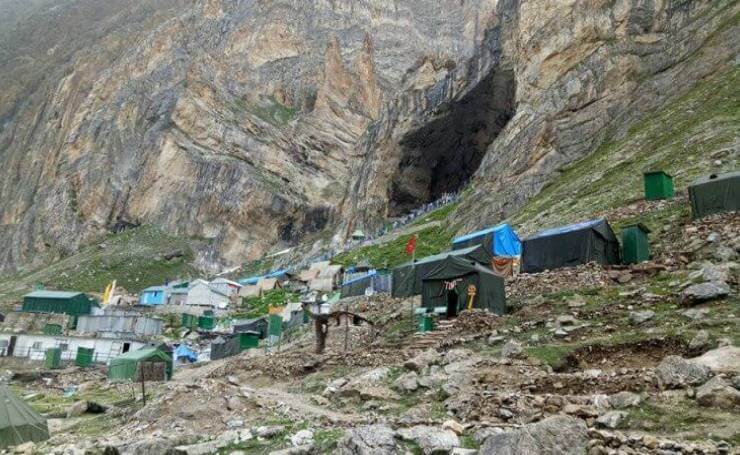
Amarnath Cave Temple is one of the most sacred and famous temples in the beautiful Kashmir region. Every year, millions of pious Hindus travel to the cave, dedicated to Lord Shiva, as part of the Amarnath Yatra. This holy journey, which is organised by the Shri Amarnathji Shrine Board, takes place in July and August when the temple is open for prayer.
The special feature of the cave, a Shivling formed by the ice naturally melting from the cave’s roof to the floor, is what makes it holy. For pilgrims, seeing this living ice Lingam is a spiritually enlightening experience. Travellers from all across India, many of whom see the Amarnath Yatra as a religious duty, make their journey to this highly religious temple over the Himalayas of South Kashmir.
The ice figure, resembling a stalagmite and representing Lord Shiva, miraculously waxes and wanes as pilgrims ascend to the temple, which is perched at an amazing 12,760 feet above sea level. The journey is evidence of the profound faith and adoration Hindus have for this hallowed location, where, in Hindu mythology, Lord Shiva bestowed upon his devoted spouse, Parvati, the essence of existence. For those making this incredible journey of faith, the Amarnath Cave Temple, with its rich history and divine aura, continues to be a beacon of spiritual significance.
Architecture of the Temple
A special and revered pilgrimage destination, the Amarnath Cave Temple is well-known for its ice Shiva Lingam. The cave is a naturally occurring feature located at an approximate altitude of 3,888 metres (12,756 ft). However, the surrounding architectural design enhances the pilgrimage experience.
The cave has a small entrance, and pilgrims must make a strenuous journey to get to this hallowed location. The cave’s construction is simple and focuses on maintaining the ice of Shiva Lingam’s original formation. During the summer, the naturally occurring ice lingam is housed in a comparatively small room called the sanctum. The temple is a popular religious site in North India and is more palatable because of its austere architectural style.
Special Things to Know
- The Amarnath cave is a 5,000-year-old wonder of the natural world.
- Within the cave are three Natural Shiva Lingas. It is thought that these stand for Lord Ganesh, Goddess Parvati, and Lord Shiva.
- This lingam is a self-manifested one that grows naturally without the assistance of humans, hence it falls under the category of Swayambhu lingams.
- The Pissu point, which is on your route to the cave, is thought to be the location where the corpses of demons that battled Lord Shiva but were defeated formerly lay.
- It has been observed that the Shivalinga’s size varies with the phases of the moon. The Shivalinga enlarges in the summer when the moon is brighter.
Timing: 6 AM to 6 PM (June/July to August)
Location: Baltal Amarnath Trek, Forest Block, Pahalgam, Jammu and Kashmir 192230
How to Reach?
The nearest railway station is Jammu. You can take a train from Delhi to Jammu or reach Srinagar airport by air. From there, one can hire cabs to reach Baltal. From Baltal, it is a 1-2 day trek (15 km) to reach Amarnath.
Akshardham Temple – Delhi
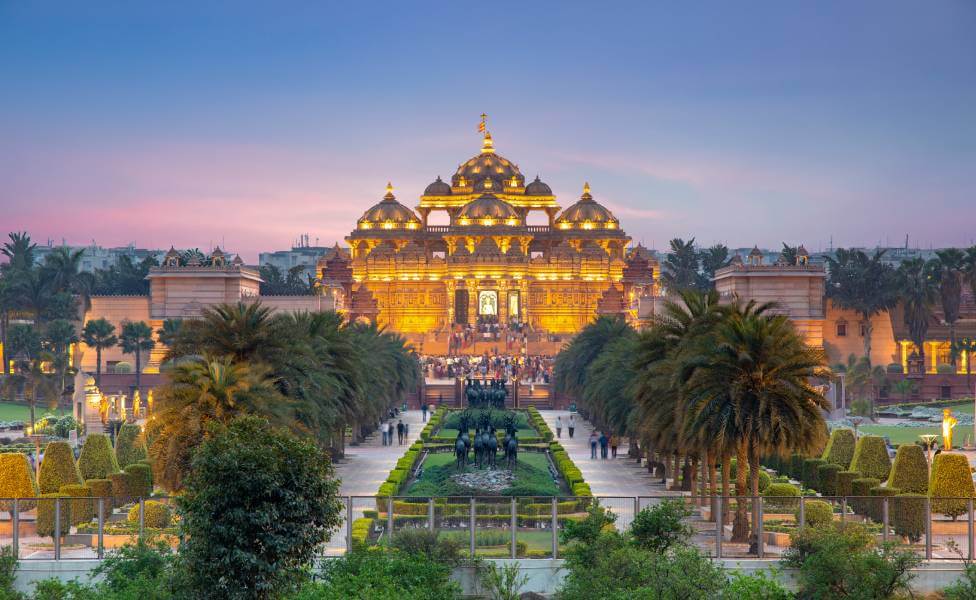
The Swaminarayan Akshardham Mandir, primarily devoted to Bhagwan Swaminarayan, contains a variety of idols representing Hindu deities, including Shiv Parvati, Sita Ram, Lakshmi Narayan, and Radha Krishna, all spread across its vast 100-acre premises. Located in the capital city of India, Akshardham Mandir is one of the most beautiful temples of North India.
The temple, which took Pramukh Swami Maharaj just five years to construct, is a symbol of pleasure, beauty, holiness, and serenity. With 234 finely carved pillars, 9 domes, 20 pinnacles, and over 20,000 sculpted figures, the 141-foot-tall, 316-foot-wide, and 356-foot-long Akshardham Mandir epitomises India’s old architectural history without the use of steel.
The focal point of the temple is an 11-foot-tall gold-plated idol of Bhagwan Swaminarayan, which is flanked by striking representations of Sri Shiva Parvati, Radha Krishna, Shri Sita Ram, and Shri Lakshmi Narayan. Outside the temple, the 611-foot-long Mandovar outside wall is embellished with 4287 carved stones, 48 murtis of Ganapati Bappa, and 200 sculpted representations of India’s most venerated Sadhus, Acharyas, Devotees, and Rishi Munis. The sacred waters of numerous lakes and rivers that Swaminarayan frequented are embraced by the Narayan Sarovar, which is located around the Akshardham Monument.
Architecture of the Temple
- The centrepiece, the Akshardham Mandir, is a magnificent building that stretches 356 feet in length, 316 feet in width, and 141 feet in height. It has 20 pinnacles, 9 gorgeous domes, and 234 painstakingly carved pillars made of pink stone and white marble. It is unique in that it is built in accordance with India’s long-standing architectural heritage without the use of steel.
- Replicating a traditional yagna kund, the Lotus-shaped Yagnapurush Kund is transformed into an enthralling water display every evening. It uses projectors, lights, fire, lasers, fountains, and other effects to convey spiritual aspects of the Upanishads. The Narayan Sarovar, which represents the sacred waters of 151 lakes and rivers that Swaminarayan visited, encircles the entire complex.
- The Mandovar is an outside wall that is 611 feet long and 25 feet high. It has 48 murtis of Ganapati Bappa and 4287 finely cut stones that show off the artist’s skill. Parikrama, a colonnade of two levels with more than a thousand pillars and almost 150 windows in each tier, spans an impressive 6,000 feet.
Special Things to Know
- Sahajanand Darshan in the temple, uses lights, music, and robotics to present Bhagwan Swaminarayan’s values.
- Neelkanth Darshan screens a film about Swamiji that is quite beautiful. His whole life and how he got to be such a saintly saint are chronicled in the movie.
- Outside food is not permitted at the temple, and cell phones, cameras, and video cameras are not permitted inside.
- The grounds of the temple have a beautiful boat ride exhibition that will transport you through India’s history, the World’s Oldest Vedic Village, a number of lively bazaars, and even Takshashila, the world’s oldest university.
- The 16 sacred signs of God are represented by the white marble footsteps of Bhagwan Swaminarayan, which are kept at the temple and serve as a symbol of his Earthly incarnation.
Timing: 10:00 am to 8:00 pm; closed on Mondays.
Location: Noida Mor, Pandav Nagar, New Delhi, Delhi, 110092.
How to Reach?
Reach Delhi from anywhere in the country by air or Train. Take a taxi or metro train to Akshardham Temple.
Shri Digambar Jain Lal Mandir – Delhi
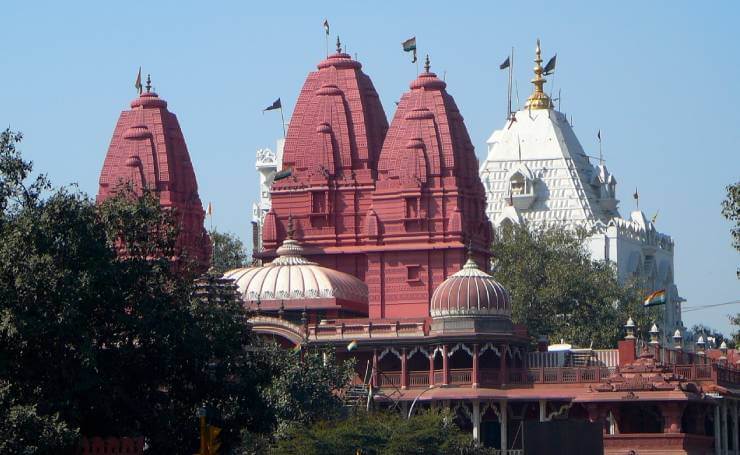
The Shri Digambar Jain Lal Mandir, is a significant spiritual site for Jains, located in most bustling streets of Delhi and is a symbol of the city’s immense religious and cultural variety. This historic Jain temple was built in the seventeenth century and is a sanctuary for Digambara Jainism devotees. Intricate carvings and vivid artwork adorn the temple’s striking crimson front, which not only draws attention but also symbolises the Jain community’s long-standing customs.
The temple offers a quiet haven away from the busy daily life, a place for reflection and introspection. Visitors can explore the teachings of Jain philosophy, participate in daily prayers, and ask the priests for blessings.
Attracting people from all walks of life with its ageless beauty, sophisticated construction, and profound spiritual importance, the Lal Mandir is a tribute to India’s rich cultural legacy. The temple is consecrated to Lord Parshvanath, the 23rd Tirthankara, and has a serene aura that draws in both ardent devotees and inquisitive guests. As soon as one enters the hallowed grounds of Shri Digambar Jain Lal Mandir, a peaceful aura surrounds them, offering a break from the busy city outside.
Architecture of the Temple
Shri Digambar Jain Lal Mandir’s architectural genius skillfully blends traditional workmanship with classic elegance. The temple’s red sandstone construction represents the enduring power of religion and its architecture is a beautiful blend of temples in North India and Mughal buildings. The temple’s architectural grandeur is enhanced by elaborately carved pillars, elaborate ceilings, and exquisitely decorated sanctums, which all combine to create an ambiance that is resonant with Jainism’s spiritual core.
The architectural design of the Lal Mandir is an intriguing blend of Rajput and Mughal elements. The exterior, made of red sandstone and adorned with fine latticework and complex carvings, is a testament to the exceptional craftsmanship of the time. The main entrance, which is surrounded by tall pillars, welcomes guests into a large courtyard that is filled with a calm ambiance.
The sanctum contains captivating idols of Jain Tirthankaras like Lord Mahavira. The temple’s splendour is further enhanced by the gold leaf and precious stone decorations found inside. Detailed murals that illustrate stories from Jain mythology add even more spiritual ambience.
Special Things to Know
- The Lal Mandir is the oldest Jain temple in Delhi and has a long and culturally significant history dating back to 1656.
- The temple compound has a special Jain Birds Hospital that tends to sick and injured birds. The Jain concept of non-violence (ahimsa) toward all living things is reflected in this endeavour.
- During several Jain holidays, especially Mahavir Jayanti and Vidhaan, the temple comes to life, drawing throngs of devotees and providing an insight into Jain customs.
Summer Timings: 5.30 AM – 11.30 AM, 6 PM – 9 PM
Winter Timings: 6.00 AM – 12 PM, 5:30 PM – 9 PM
Location: Netaji Subhash Marg, Chandni Chowk, Delhi – 110006 (Opposite Red Fort).
How to Reach?
Reach Delhi by flight or Train from anywhere in the country. Once in Delhi, take a metro train or taxi to Chandni chowk which is 10 minutes of walking distance from the temple.
Ranakpur Temple – Pali, Rajasthan
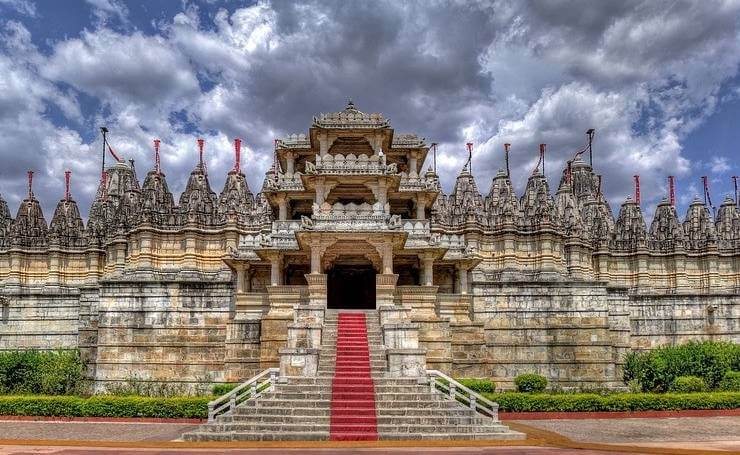
A major destination for Jain devotees, Ranakpur Temple is an exquisitely gorgeous temple situated in Rajasthan’s tranquil Aravalli Range. Constructed in the fifteenth century with Rana Kumbha as its patron, this Jain temple is well-known for its exquisite architecture and exquisite marble work. One of the most significant and breathtaking Jain temples in the world is the Ranakpur Temple because of its remarkable combination of styles, immense size, and fine decoration. For Jains, it is a site of pilgrimage, and for lovers of art, architecture, and beauty, it is a must-visit pilgrimage destination in North India.
The intricately carved pillars of the temple are its most remarkable feature. With elaborate carvings of gods, animals, flowers, and geometric designs, each item is a work of art. Interestingly, no two pillars are the same. The temple’s ceiling is a masterpiece as well, with elaborate patterns painted in eye-catching hues.
The 48,000 square foot Ranakpur Temple complex is situated on an elevated platform. For Jains, the temple is a highly significant place of pilgrimage, dedicated to Adinatha, the first Tirthankara of Jainism. Visitors are drawn in by the captivating sight of the beautiful white marble façade of the temple complex as they approach it, rising out of the verdant surroundings. The arches and domes of the temple show influences from various architectural forms, including Indo-Islamic, even though Jain architecture predominates. Ranakpur Temple is regarded as one of India’s most exquisite temples and is rightfully regarded as a masterpiece of Jain construction.
Architecture of the Temple
Ranakpur Temple’s architecture represents the Dharna Vihara style, which is distinguished by its intricate workmanship and rich design. The fundamental design follows the principles of the Maru-Gurjara architectural style, which is distinguished by its elaborate carvings and use of marble. The sheer size and complexity of the building as soon as one enters the temple complex astounds tourists. The immense construction of the temple is supported by 1,444 finely carved marble pillars, 24 pillared halls, and 80 unique-designed domes. The pristine white marble, which comes from the adjacent Makrana quarry, gleams in the sunlight and gives off an almost ethereal aura.
Mandapas (halls), shikhara (spires), and delicately carved domes display the unmatched artistry of craftspeople from a bygone era. The interior of the temple is illuminated by natural light thanks to its layout, which adds to the hallowed place’s ethereal splendour. Beautiful sculptures representing scenes from Jain mythology, flora and animals, and geometric patterns adorn each pillar, archway, and ceiling panel. The focal point of the complex is the central shrine, which is home to the four-faced deity of Lord Rishabhanatha. One white marble block was used to chisel the Chaumukha Adinatha statue, which is regarded as a masterpiece of Jain art. There are four smaller shrines surrounding the sanctum, each honouring a different Tirthankara.
Special Things to Know
- Ranakpur Temple is one of the UNESCO World Heritage Sites. In 2010 it was added to the list of World Heritage Sites as a testament to its exceptional universal value.
- In addition, the temple complex has a dining hall called Bhojanshala and a guest house called Dharamsala where guests can stay and dine.
- In the centre sanctum, there is a Chaumukha Adinatha (Four-Faced idol) carved out of a single piece of white marble. It is a well-known Jain masterpiece.
Timing: 6 AM to 7 PM
Location: Ranakpur Rd, Sadri, Rajasthan 306702.
How to Reach?
Reach Maharana Pratap Airport in Udaipur, approximately 90 kilometres from Ranakpur. Take a taxi from Udaipur airport to Ranakpur.
Mansa Devi Temple – Haridwar, Uttarakhand
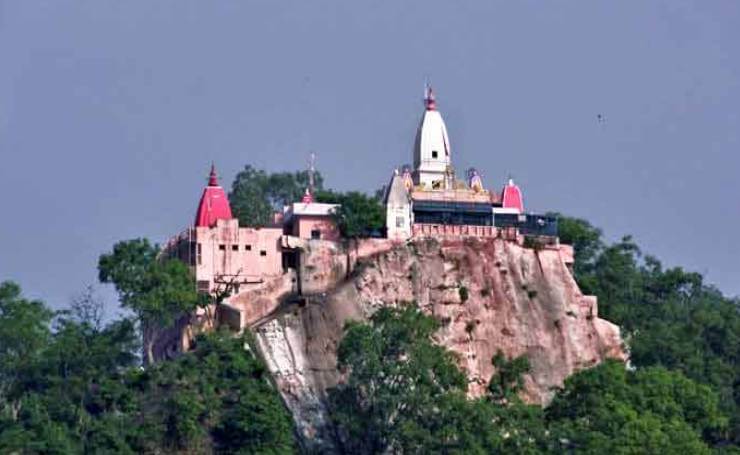
Perched on the gateway to the Himalayan region, Mansa Devi Temple in Haridwar beckons millions of devotees annually with its spiritual resonance and architectural splendour. Situated amidst the enchanting foothills of the Shivalik range on Bilwa Parvat, this revered pilgrimage site is dedicated to Goddess Mansa Devi, known as the “fulfiller of wishes.” Climbing the Bilwa Parvat reveals the temple’s imposing white building, which is embellished with elaborate carvings and tall spires, set against the backdrop of verdant woodlands.
Travellers seeking a sublime experience can choose between the strenuous 3-kilometre trek and the picturesque Udan Khatola cable car, which offers sweeping views of the Ganges River and Haridwar. A vital component of Haridwar’s religious and cultural traditions, Mansa Devi Temple celebrates a number of festivals, such as Navratri and Kumbh Mela. The temple has great spiritual significance because it is one of the three Siddh Peeths, along with Maya Devi and Chandi Devi. It is believed by devotees that tying a thread on the temple tree grants their wishes and establishes a strong bond with the deity. The temple blends spiritual devotion with natural beauty, creating a sacred retreat with its tranquil atmosphere and captivating views.
Architecture of the Temple
The Mansa Devi Temple combines Rajput and Nagara architectural elements to create a captivating architectural symphony, is a monument of creative genius. The temple, which is made of white marble, exhibits a passion for craftsmanship with its exquisite carvings, delicate latticework, and majestic arches. Crowned with a gold-plated kalash, the towering shikara functions as a spiritual lighthouse. Inside, Mansa Devi is housed in the central shrine. She is beautifully decked with magnificent jewellery and covered in vivid silks, resulting in a harmonic combination of grandeur and serenity. Admirers of Indian culture and spiritual searchers will find a compelling masterwork in the several shrines devoted to diverse goddess forms, all of which are adorned with the classic temple architecture of North India.
Special Things to Know
Mansa means “wishes” thus Goddess Mansa Devi is revered as the “fulfiller of wishes,” millions of pilgrims visit this sacred location each year.
To express their desires and supplications to the goddess, devotees bind sacred threads around the temple railings and the branches of a sacred tree close to the main shrine. Here, faith is embodied in this small act.
The festivals of Durga Puja and Navratri bring the Mansa Devi Temple to life. If your trip falls during one of these festivals, make sure you attend it.
Mansa Devi Temple is regarded as one of the Siddh Peethas, which are locations thought to be where Goddess Sati’s body parts fell during the legend of Lord Shiva’s destructive dance (Tandava).
Timing: Summer – 4 AM to 10 PM, Winter – 5 AM to 9 PM.
Location: Haridwar, Ranipur Range, Uttarakhand 249403.
How to Reach?
Nearest railway station to reach Mansa Devi Temple is Haridwar railway station (3 km). Take a train from Delhi to Haridwar.
Iskcon Temple – Vrindavan, Uttar Pradesh
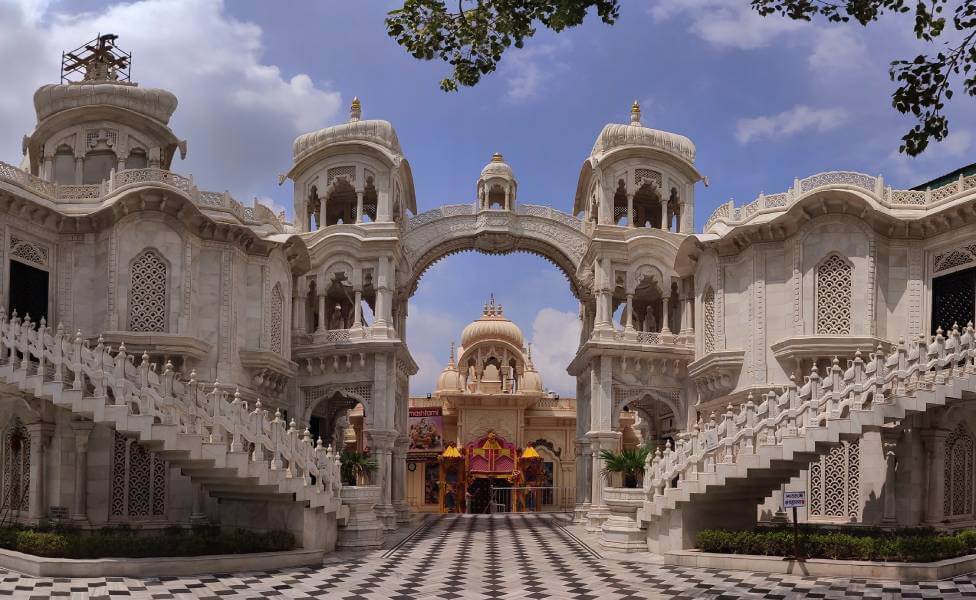
The ISKCON Temple, also known as Sri Sri Krishna Balram Mandir, stands as a spiritual oasis devoted to Lord Krishna. Built in 1975 under the direction of the ISKCON Trust, it has grown to be a significant spiritual site that draws both pilgrims and visitors. The temple’s distinctive architecture draws people in addition to its religious significance. As one enters the gorgeous white marble archway that leads to Prabhupada’s samadhi, the atmosphere changes to one of spirituality. The sound of the harmonium, kartals, and mrdanga fills the temple, offering a unique experience. The altar honouring the heavenly brothers Balaram and Krishna is the main draw. The temple offers a variety of aartis during the day, which heightens the aura of the hallowed place. To complete the experience, guests also participate in Khichdi, a wonderful offering.
Architecture of the Temple
The ISKCON Temple in Vrindavan is a striking example of a spiritually serene and opulent combination. It is a white marble edifice with beautiful carvings that greets guests through a grand archway that leads to Prabhupada’s samadhi. Inside, the massive wooden temple doors envelop believers in a hallowed atmosphere. The main shrine, honouring Balaram and Krishna, has exquisite decoration. There are sections of the temple complex dedicated to Nitai Gaur, Krishna Balaram, and Radha Krishna. The temple’s courtyard, which strictly adheres to timetables, reverberates with the spiritual fervour of kirtans and aartis, offering both devotees and enthusiasts of holy architecture an unforgettable experience.
Special Things to Know
- The founder of ISKCON, Swami Prabhupada, had a dream that commenced the ISKcon Temples. It was the first of the ISKcon temples.
- A museum honouring the life of Srila Prabhupada and the history of ISKCON is located within the temple. This museum sheds light on the beginnings and development of this worldwide spiritual movement.
- The temple ought to be built where Lord Krishna and Balarama spent their formative years.
- The Iskcon Temple actively participates in a number of social welfare programs, giving the underprivileged access to food, education, and healthcare. The essential ideas of Krishna consciousness are reflected in this commitment to service.
Timing: 4 AM to 12:30 PM and 4:30 PM to 8:30 PM.
Location: Bhaktivedanta Swami Marg, Raman Reiti, Vrindavan, Rajpur Khadar, Uttar Pradesh 281121.
How to Reach?
From Delhi, hire a taxi or train to Vrindavan to reach the temple. This journey will take about 4-5 hours.
Vaishno Devi – Katra, Jammu and Kashmir
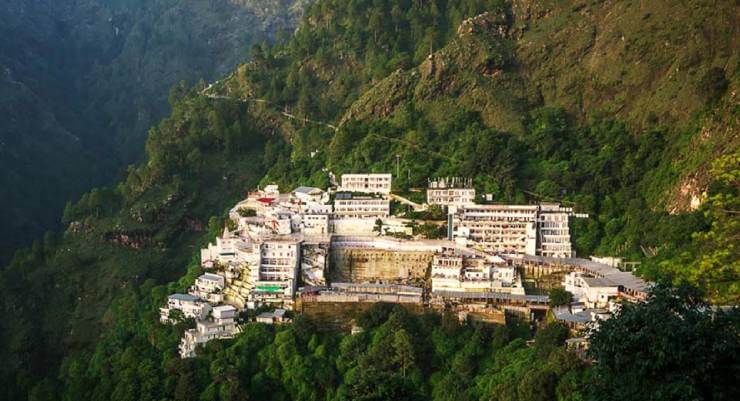
In the mesmerising Trikuta hills of the Himalayas in Jammu & Kashmir, Vaishno Devi Temple is a highly pious pilgrimage site that draws people from all walks of life. The trip to the temple, which is located close to Katra, is difficult but spiritually enlightening. Seeking blessings along the way, pilgrims set out on a four to five-hour trip that passes through Charan Paduka, Ardhkuwari, and Hathi Matha. Pithus, waggies, and horse services are available for persons who are unable to walk. Travellers are guaranteed convenience as these services are overseen by the local committee. The trek from Katra to Vaishno devi Bhawan, spanning 13 km, offers different routes, each varying in distance.
The Bhairon Temple, located 4-5 miles uphill from Vaishno Devi, is a must-see temple for pilgrims in north India. It is important to the pilgrimage since it is dedicated to Baba Bhairavnath, and it is believed that obtaining Bhairon’s blessings is essential. The Bhairavnath shrine is reachable either by trekking or using ponies and palkies.
For an added spark of fun and excitement, a helicopter ride is available, accommodating 5-6 passengers. Booking in advance is advisable, and the 8-minute ride from Katra’s helipad to Sanjichhat offers a quicker route to Vaishno Devi Bhawan. Whether on foot or by air, the pilgrimage to Vaishno Devi is a holistic journey, blending physical endurance with spiritual devotion.
Architecture of the Temple
The intricate and captivating architecture of the Mata Vaishno Devi temple complex is housed within a naturally occurring cave. The temple’s architecture blends classical aesthetics with the surrounding natural environment. The building, which honours Goddess Vaishno Devi, is simple in design and has delicate yet detailed carvings.
The primary draw is the sacred cave, which is home to the three Pindies, who stand in for the goddesses Saraswati, Lakshmi, and Kali. Followers follow a tight, twisting trail into the cave, which is decorated with colourful illumination and mysterious decorations, before reaching the holy darshan. The temple complex emerges from the cave into a sequence of courtyards, halls, and shrines, each with a unique architectural significance. The Bhawan of Mata Vaishno Devi features a grand Shikhara, adorned with intricate gold leaf work, soaring towards the sky.
The facility oozes grandeur and peace due to the extensive use of sandstone and white marble. The elaborate Hindu mythological figures carved on the arches, pillars, and walls enhance the temple’s ethereal atmosphere.
Special Things to Know
Goddess Durga’s revered form, Mata Vaishno Devi, spent nine months in the holy cave meditating and requesting blessings for the entire world.
The temple complex has a number of amenities for pilgrims, including as food vendors, free lodging, and medical care. Everyone will have a comfortable and satisfying journey because of the commitment to service and compassion, which reflects the pilgrimage’s essential ideals.
The journey from the Katra helipad to Sanjhichhat, near Vaishno Devi Bhawan, takes around eight minutes.
Timing: 5 AM to 12 PM and 4 PM to 9 PM.
Location: Mata Vaishno Devi Shrine Board, Katra District Reasi, Jammu and Kashmir, PIN – 182301.
Golden Temple – Amritsar, Punjab

Golden Temple, or The Harmandir Sahib Gurudwara of Amritsar is Sikhism’s holiest religious site and the epicentre of the faith. The holy city of Amritsar, which was founded in 1574 by the fourth Sikh Guru Ram Das, got its name from the “pool of the nectar of immortality” that surrounded the Golden Temple. The city grew up around this important pool since it is said that bathing in this holy water purifies one.
The Holy Tree, the centre of the Golden Temple, is where the great Sikh Guru Baba Budha Ji laid the groundwork for this amazing location while he slept beneath it. The resilient history of the temple, characterised by both repair and devastation, is a testament to the tenacity of Sikh devotion. Maharaja Ranjit Singh covered it with 750 kg of pure gold in 1809, earning it the name “The Golden Temple.”
The holy tank, a moat encircling the temple, is a place of self-cleansing where people come to wash away their sins and ward off illness. The temple invites people of all races, religions, and cultures to enjoy its spirituality and beauty as a symbol of inclusivity.
This religious site in Northern India serves beyond a religious pilgrimage as the Golden Temple is home to the Langar, a communal kitchen where guests are fed basic vegetarian meals regardless of their financial situation, caste, or religion. This well-run enterprise gives a community in need access to clean water, showers, sleeping quarters, and restrooms in addition to food. Serving as a volunteer at this amazing location is a rewarding experience that demonstrates the temple’s dedication to equality and unselfish devotion.
Architecture of the Temple
The Golden Temple in Amritsar boasts a captivating blend of architectural influences, showcasing a harmonious fusion of Indo-Islamic Mughal and Hindu Rajput styles. This two-storied marvel rises 67 feet high, featuring a lower level crafted from marble and an upper level adorned with gold panels. The crowning glory is a 750 kg gold-gilded dome. The temple’s interior, embellished with floral motifs and gold-lettered Sikh scripture, resonates with elegance. Surrounding the sacred pool, Amrit Sarovar, the temple complex includes structures like Akal Takht, a clock tower, a museum, and the Langar, symbolising the unity of Sikh community service. Each element narrates a tale of architectural brilliance and cultural significance.
Special Things to Know
- The main structure of the temple is covered with real gold leaf, symbolising spiritual and material wealth.
- Five thousand people can sit in the langar hall of the Golden Temple at one time.
- The sacred pool around the temple is believed to have healing properties. Pilgrims take a dip in its holy waters as part of a spiritual cleansing ritual.
- The Golden Temple runs one of the largest free community kitchens in the world, serving meals (langar) to thousands of people daily, regardless of their religion, caste, or background.
- The Guru Granth Sahib (Religious scripture of Sikhism), is continuously recited inside the Golden Temple, taking around 48 hours to complete for once.
- An estimated 50,000–100,000 meals are provided daily by Golden Temple.
- The Golden Temple’s design incorporates architectural elements from different religions, symbolising the Sikh belief in the universality of spirituality. The four entrances signify openness to all, irrespective of their origin or beliefs.
Timing: Open 24 hours.
Location: Golden Temple Rd, Atta Mandi, Katra Ahluwalia, Amritsar, Amritsar Cantt., Punjab 143006
How to Reach?
Take a flight to Sri Guru Ram Dass Jee International Airport or a train to Amritsar Junction from any major city in India. From there, it’s a short drive or walk to the temple.
I trust that this information proves valuable in planning your exploration of the renowned temples in North India. These temples are truly must-visit destinations in the region. Your feedback and suggestions are greatly appreciated; feel free to share your comments in the section below.
About the author
With a deep affection for places and their stories, Gulshan is a travel writer who brings destinations to life. His vivid narratives make readers feel as if they're experiencing these locales firsthand. Gulshan's straightforward yet detailed descriptions inspire a sense of curiosity and a desire to explore the world.

 +91-9212777225
+91-9212777225 Plan Your trip
Plan Your trip